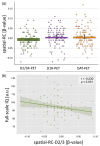Indirect evidence for altered dopaminergic neurotransmission in very premature-born adults
- PMID: 37608591
- PMCID: PMC10502650
- DOI: 10.1002/hbm.26451
Indirect evidence for altered dopaminergic neurotransmission in very premature-born adults
Abstract
While animal models indicate altered brain dopaminergic neurotransmission after premature birth, corresponding evidence in humans is scarce due to missing molecular imaging studies. To overcome this limitation, we studied dopaminergic neurotransmission changes in human prematurity indirectly by evaluating the spatial co-localization of regional alterations in blood oxygenation fluctuations with the distribution of adult dopaminergic neurotransmission. The study cohort comprised 99 very premature-born (<32 weeks of gestation and/or birth weight below 1500 g) and 107 full-term born young adults, being assessed by resting-state functional MRI (rs-fMRI) and IQ testing. Normative molecular imaging dopamine neurotransmission maps were derived from independent healthy control groups. We computed the co-localization of local (rs-fMRI) activity alterations in premature-born adults with respect to term-born individuals to different measures of dopaminergic neurotransmission. We performed selectivity analyses regarding other neuromodulatory systems and MRI measures. In addition, we tested if the strength of the co-localization is related to perinatal measures and IQ. We found selectively altered co-localization of rs-fMRI activity in the premature-born cohort with dopamine-2/3-receptor availability in premature-born adults. Alterations were specific for the dopaminergic system but not for the used MRI measure. The strength of the co-localization was negatively correlated with IQ. In line with animal studies, our findings support the notion of altered dopaminergic neurotransmission in prematurity which is associated with cognitive performance.
Keywords: Blood oxygenation fluctuations; amplitude of low frequency fluctuations; dopamine PET; dopaminergic neurotransmission; premature birth; resting-state fMRI.
© 2023 The Authors. Human Brain Mapping published by Wiley Periodicals LLC.
Conflict of interest statement
The authors have no conflict of interest to declare.
Figures


References
-
- Ashburner, J. (2007). A fast diffeomorphic image registration algorithm. NeuroImage, 38, 95–113. - PubMed
-
- Babu, P. , & Stoica, P. (2010). Spectral analysis of nonuniformly sampled data—a review. Digital Signal Processing, 20, 359–378.
-
- Ball, G. , Aljabar, P. , Zebari, S. , Tusor, N. , Arichi, T. , Merchant, N. , Robinson, E. C. , Ogundipe, E. , Rueckert, D. , Edwards, A. D. , & Counsell, S. J. (2014). Rich‐club organization of the newborn human brain. Proceedings of the National Academy of Sciences of the United States of America, 111, 7456–7461. - PMC - PubMed
Publication types
MeSH terms
Substances
LinkOut - more resources
Full Text Sources

